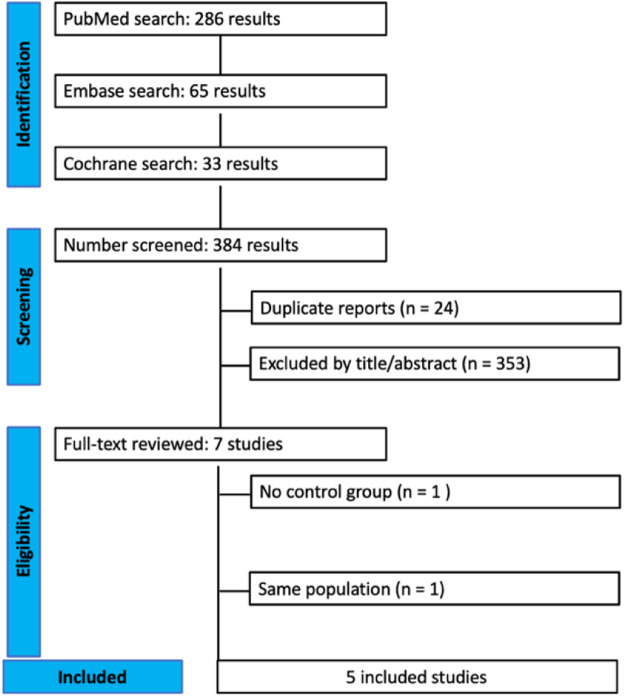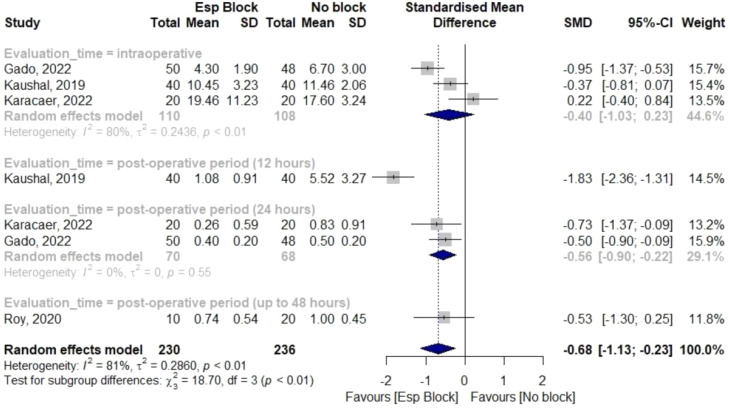Efficacy of Erector Spinae Plane Block (ESPB) in pediatric cardiac surgeries: a systematic review and meta-analysis
IF 1.9
4区 医学
Q2 ANESTHESIOLOGY
引用次数: 0
Abstract
Background
Erector Spinae Plane Block (ESPB) effectively reduces pain scores for sternotomy in adults. However, evidence is insufficient to assert that the same result occurs in children. The aim of this systematic review and meta-analysis was to evaluate the efficacy of ESPB in pediatric cardiac surgeries.
Methods
Systematic Medline, Embase and Cochrane searches were conducted for studies that compared ESPB versus no block or sham block for pediatric cardiac surgery under sternotomy. The primary outcome was cumulative opioid consumption for up to 48 hours. Statistical analyses were carried out with the use of RStudio version 1.2.1335. Heterogeneity was assessed by Cochran's Q test and I2 statistics. Quality assessment and risk of bias assessment complied with Cochrane recommendations.
Results
Five studies, involving 328 patients (3 Randomized Controlled Trials [RCT], and 2 cohorts) were included. Of the 328 patients, 160 (48.7%) underwent ESPB. There were significant reductions in cumulative opioid consumption up to 48 hours after ESPB (SMD -0.68; 95% CI -1.13 – -0.23; p < 0.01). In the following outcomes ESPB failed to show superiority: postoperative nausea and vomiting (OR = 0.56; 95% CI 0.25–1.23; p = 0.54), fever (OR = 0.75; 95% CI 0.24–2.31; p = 0.58), length of intensive care unit stay in hours (MD -2.42; 95% CI -5.47–0.64; p < 0.01] and length of hospital stay in days (MD -0.87; 95% CI -2.69–0.96; p = 0.02). Only one cohort study had a high risk of bias.
Conclusion
ESPB potentially reduces postoperative pain by significant reductions in cumulative opioid consumption up to 48 hours in pediatric cardiac surgery patients.



直立脊柱平面阻滞(ESPB)在小儿心脏手术中的疗效:一项系统综述和荟萃分析。
背景:直立脊柱平面阻滞(ESPB)可有效降低成人胸骨切开术的疼痛评分。然而,证据不足以断言儿童也会出现同样的结果。本系统综述和荟萃分析的目的是评估ESPB在小儿心脏手术中的疗效。方法:系统的Medline, Embase和Cochrane检索了比较ESPB与无阻滞或假阻滞在小儿胸骨切开心脏手术中的研究。主要终点是长达48小时的阿片类药物累积消耗。使用RStudio 1.2.1335版本进行统计分析。异质性采用Cochran’s Q检验和I2统计量进行评估。质量评估和偏倚风险评估符合Cochrane的建议。结果:纳入5项研究,共328例患者(3项随机对照试验[RCT], 2个队列)。在328例患者中,160例(48.7%)接受了ESPB。ESPB后48小时内,累计阿片类药物消耗显著减少(SMD -0.68;95% ci -1.13 -0.23;P < 0.01)。在以下结果中,ESPB未能显示出优势:术后恶心和呕吐(OR = 0.56;95% ci 0.25-1.23;p = 0.54),发热(OR = 0.75;95% ci 0.24-2.31;p = 0.58)、重症监护病房住院时间(MD -2.42;95% ci -5.47-0.64;p < 0.01]、住院天数(MD -0.87;95% ci -2.69-0.96; = 0.02页)。只有一项队列研究存在高偏倚风险。结论:ESPB可能通过显著减少儿童心脏手术患者长达48小时的阿片类药物累积消耗来减轻术后疼痛。
本文章由计算机程序翻译,如有差异,请以英文原文为准。
求助全文
约1分钟内获得全文
求助全文
来源期刊

Brazilian Journal of Anesthesiology
ANESTHESIOLOGY-
CiteScore
2.10
自引率
0.00%
发文量
88
审稿时长
68 days
 求助内容:
求助内容: 应助结果提醒方式:
应助结果提醒方式:


